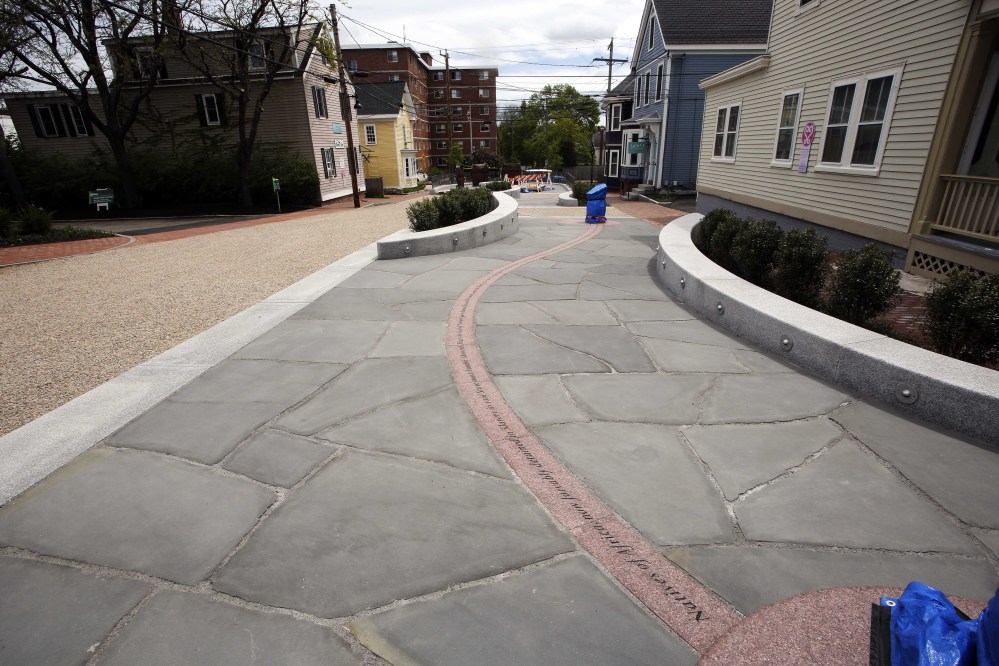CONCORD, N.H. — From installing sculptures to planting grass, constructing Portsmouth’s newest park posed a unique challenge: deep digging was off limits given the hundreds of bodies buried below the site.
The remains, however, are the very reason for the $1.2 million African Burying Ground Memorial Park, which returns the property to sacred ground and honors the enslaved and free men and women who played key roles in the city’s early history.
Slavery existed in New Hampshire as early as the mid-1600s and was concentrated in Portsmouth, a thriving seaport. Although city documents referred to the Chestnut Street area as a “Negro burying ground” as early as 1705, few modern-day residents knew about it until 2003, when city workers digging up the road for a sewer project found wooden coffins and the remains of 13 people.
The discovery trigged communitywide discussions not just about what to do with the site going forward, but about the city’s past, said Stephanie Seacord, spokeswoman for the African Burying Ground Committee.
“Why didn’t we pay attention to it? That’s been a really central part of the conversation,” she said. “This isn’t just another monument being dedicated, it’s a conversation.”
The park’s motto is “We Stand in Honor of Those Forgotten.” At the entrance stands a bronze sculpture created by Jerome Meadow of Savannah, Georgia, featuring a woman and man standing back to back on opposite sides of a tall slab of New Hampshire granite.
The female figure represents Africa, while the male figure represents the first African to be enslaved in Portsmouth. Their hands reach around the edge of the wall, not quite touching, to represent both the separation wrought by slavery and present-day efforts toward reconciliation.
Winding through the center of the park are paving stones etched with phrases from an unsuccessful petition submitted by 20 slaves to the New Hampshire Legislature in 1779 during the Revolutionary War. The men, who had fought in the war, asked that the freedom sought by colonists be extended to them and argued “public tyranny and slavery are alike detestable to minds conscious of the equal dignity of human nature.” Six of the slaves were later freed and 14 died in bondage with legislators never acting on their request.
In 1857, four years before the start of the Civil War, the Legislature passed a law stating that “No person, because of descent, should be disqualified from becoming a citizen of the state,” and in 2013, Gov. Maggie Hassan granted the original petitioners posthumous emancipation.
Supporters of the legislation said they hoped it would encourage future generations to pursue social justice, a sentiment that is expressed in the park through a West African symbol that translates to “Return and Get It – Learn from the Past.”
At the far end of the park stands a metal fence embedded with colorful ceramic tiles created by local middle school students, and the underground burial vault where the remains removed in 2003 will be reburied on Saturday morning.
That somber ceremony will be followed by a community celebration at Portsmouth Middle School and a concert Saturday night at The Music Hall.
City officials say the Portsmouth site is the only known African burying ground in New England that dates to the 1700s. A similarly authenticated burying ground in lower Manhattan is now a national park.
According to the latest U.S. Census estimates, black people make up just 1.5 percent of New Hampshire’s 1.3 million residents. But throughout the project’s 12 years of planning, fundraising and construction, one expression resonated, said Seacord: “This isn’t black history or white history, it’s our history.”
Send questions/comments to the editors.



Success. Please wait for the page to reload. If the page does not reload within 5 seconds, please refresh the page.
Enter your email and password to access comments.
Hi, to comment on stories you must . This profile is in addition to your subscription and website login.
Already have a commenting profile? .
Invalid username/password.
Please check your email to confirm and complete your registration.
Only subscribers are eligible to post comments. Please subscribe or login first for digital access. Here’s why.
Use the form below to reset your password. When you've submitted your account email, we will send an email with a reset code.